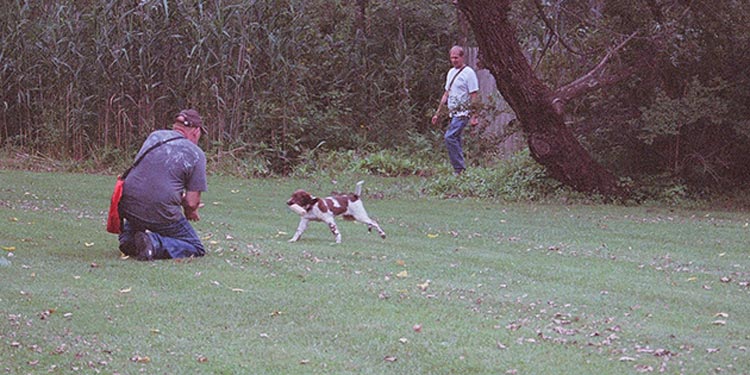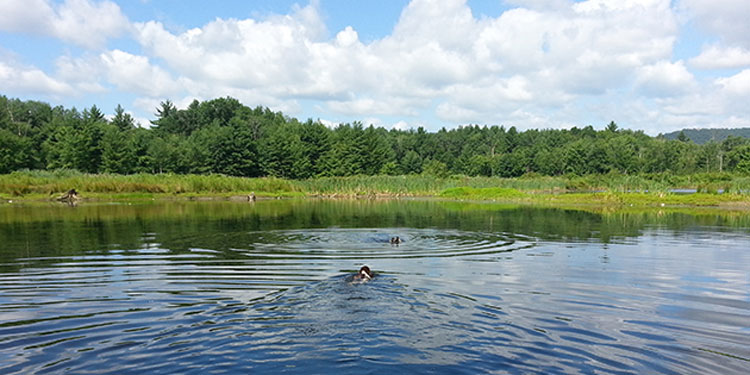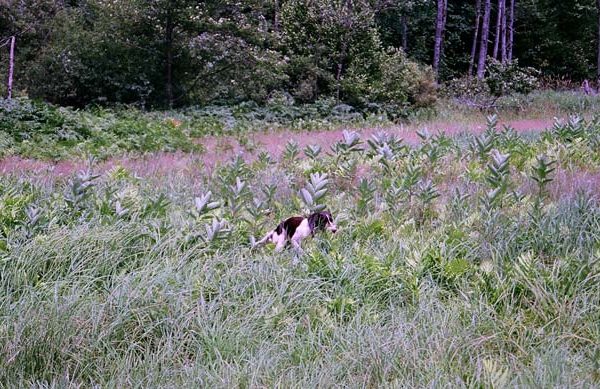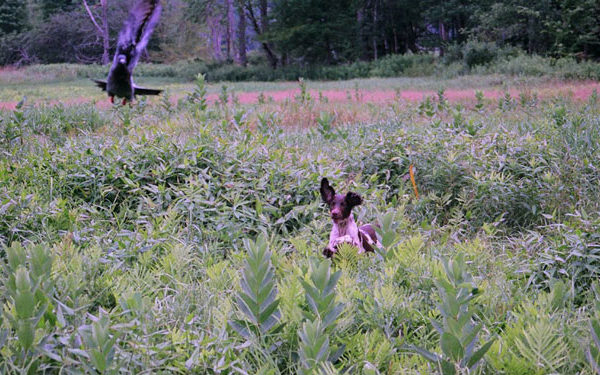
Since it is that time of year and many folks now have added a new future hunting partner to their clan, I thought that I would take this opportunity to touch on some of the basics and some of the subconscious training that a professional trainer does when dealing with a very young spaniel during the introductory stage to field work. Now, this really is the stage before any real formal field training begins. The period I am referring to is your spaniel’s very first trip in the field. I will cover some of the reactions and what happens when we see the pup’s response to new things. I will also discuss how, as professionals, we handle these unfolding situations and what we do to get a proper response during the pup’s introduction to new surroundings and situations.
Before I get started into the proper techniques of field introductory, I would like to touch on some of the pitfalls that I see on a regular basis at my training facility. Clients often take the initiative of starting their pup’s training out in the field and are not aware of the potential issues that can or have arisen in the process. Many first time puppy owners tend to fall into these pitfalls during this stage of subconscious training. Once these errors are established during the introduction stage, they often tend to carry over into all levels and many different stages of field training, and unless corrected they can affect the spaniel’s entire career.
Here are a few golden rules to keep in mind while you are going through the basics of field introduction and completing your training program.
1. Be patient with your new pup during this phase of introduction. You should have done your homework on getting a spaniel from a strain of dogs that will fit your needs. It is just a matter of time before their genetics will cause them to overcome their fears of the new big world out there.
2. Keep quiet! Do not continue to “hack” at your pup attempting to coax him to get out to investigate scent or find birds. I can’t recall how many times I have heard this phrase from so many folks, “ Fido, go find the birdie”. The only thing that is being accomplished by attempting to coaxing the young or even an older spaniel is that you are distracting the spaniel from developing his natural ability and desire to find game and making him more dependent on you rather than using his own natural instincts. Here is a golden rule; the more you talk to your pup the more he becomes distracted in finding game. This will only cause him to be less proficient in finding and flushing game. Keep quiet and be patient, let your spaniel develop on his own incentive. This will not only build confidence but also affect both his attitude and nose scenting abilities. Coaxing does nothing more than undermine the whole training process. This can also become a bad habit that will spill over into every aspect of training if not detected.
I suggest that during this new introduction that you visit the same field and enter the field from the same direction all the time until your pup has become well developed in their field confidence. Eventually, as his confidence builds you can start to enter the field at different directions and finally choose many different fields that will offer different types of cover and terrain. This will also help your pup to become familiar and accustomed to many types of cover, scents, wind direction, etc.
The first several trips to a local field, your new pup will probably stick to you like glue. He will tend to follow in your footsteps as “you lead the way” in investigating this new field. This can become very frustrating as your pup continues to “stick to you” and not venture out looking for good things to smell or chase. However, be patient! Your pup is very insecure about this new big world that you are attempting to introduce him to. Naturally, because of instincts, he is going to stay close to you for protection.
As you walk, take your time and stop for several minutes to let the pup take his focus off of you and possibly find a good smelling scent on the ground behind you. It will be just a matter of time before you will stumble upon the right spot that will have such a tantalizing scent that you pup’s curiosity and genetic make-up causes him to smell and follow the scent, leading him further and further away from your feet.
The final stage of “field introduction” should take place in heavy and dense cover. As this begins to unfold just stand quietly and let junior investigate his new found scent. When he does finally realize that he is a little further away from you then he likes to be, give him lots of praise when he comes charging back to you for security. As time unfolds you will find that junior will start to enjoy using his nose to smell all of those great scents and he will begin to wander a little farther away from you each time afield.
During this time keep quiet and let him develop his nose for tracking scent. This is also a good time to discipline yourself on stopping and watching your spaniel when he puts his nose to the ground in search of game. Never disturb your pup with any sort of command when he has his head down and is interested in hunting or scenting game. Always wait until he has lifted his head and no longer interested in the track to prevent distracting him by intervening with a command.
However, this is also a good time to teach the pup his proper place in the field, as he wonders off looking for scent or chasing a flying butterfly. Always turn yourself, facing in the direction of the pup. Every time your pup looks up he will see the front of you. The pup will subconsciously learn that his place in the field is out in the front of you rather than behind you. Eventually, you will be able to walk forward in your desired direction and your spaniel will address you properly in the field.
Once developed, you can begin to teach your pup to change direction. At this point, I will start to introduce the whistle into the scheme of things. Timing is very important here. Wait until your pup has lifted his head and is not interested in investigating scent. Once your are certain, turn and walk in the opposite direction away from your pup. As you do this, hit the recall whistle to get your pup’s attention. You will be surprised on how quickly he will pick up on this and run charging past you to get out in front of you again.
The final stage of this type of field introduction should take place in some heavy and dense cover. This is the time to teach the youngster to take his proper place in the field in heavy cover. You will find that the pup will be very setback by this type of intimidating cover. I would not be surprised if junior will resort back to being a “heal hound” for the first few times he is in such cover, letting you lead the way through the underbrush.
Not to worry, be very patient. Keep quiet and by all means do more stopping and waiting than walking. Allow your pup time to find out that there are some very interesting scents in this overwhelming cover and give him time to investigate them. In no time at all you will have positively introduced your young spaniel to the field. Additionally, you will have not starved them from developing their natural ability to their full potential.
Simple concepts used during the early stages of a spaniel’s life can assist in making that wonderful productive field dog and family companion.





